Contents









Sometimes a country will for days keep its secrets from a traveller, showing him nothing but its surfaces, its grass, its trees, the outside of its houses. Then suddenly it will throw him a key and tell him to go where he likes and see what he can.
Thus wrote Rebecca West in her travelogue Black lamb and Grey Falcon. And one of the possible keys to the tourist destinations of Serbia, whether you come from afar or from the immediate neighbourhood, must be food.
Food bridges the gap between the most basic human needs and the most sensual and cultur al desires, elevating the simple act of preparing meals to an art. The brochure in your hands covers only part of the gastronomic wealth of Serbia selected on the basis of geographical identity and protected regional products.
fered a well prepared meal in Serbia, one often hears: “Try this! It speaks six languages and stutters in a seventh”. And when you try it, you realise that the mention of “stuttering” is just a charming trick of culinary modesty, dis creetly fishing for a compliment. The language of food, just like the language of flowers and other niceties of nonverbal communication, is easy on the ear and long in the memory.
Serbia’s turbulent history has left its mark on the country’s food, a cuisine which derives from the four corners of the world. However the bountiful climate and imaginative local population have ensured that both culinary originals and variations are at once magnifi cent and communicative. When guests are of

Serbia’s climate and topography vary widely from region to region. On the plains, the cli mate is continental while the mountains en joy typical mountain weather with temperate climate variations in the river valleys, while the southwest approaches the Adriatic-Med iterranean climate. Topography and climate are reflected in biodiversity and agriculture and these in their turn have an impact on gas tronomy: someone with a large appetite is de scribed as eating like a blizzard, while one who eats modestly is said to eat like a bird. But the conventional wisdom among Serbs is that it is better to eat more because “strength goes in through the mouth,” and “a passionate eater is a passionate worker”.
But while the delicious tastes and smells of Serbia are undoubtedly fuel for passionate ap petites, this country also has a long tradition of healthy eating. In generations past, Ortho dox Serbs observed strict rules of fasting under which foods of animal origin were not eaten on Wednesdays or Fridays, nor during Lent or Advent. Of course they also abstained from sinful thoughts and deeds during these times. This meant that there were fasting days during the year than there were days on which meat and dairy products could be eaten, so it was important to develop recipes and methods of food preparation which we now recognise as healthy.
So if you’re a vegetarian, you’ll find Serbian food thoroughly enjoyable, but if you’re not, there’s nothing to fear. Even in the old days, Serbs were pragmatic enough not to insist on travellers fasting. What’s more, Serbs are a hos pitable nation, so from the elegant restaurants of the capital, through the lively inns and tav erns in the rest of the country, to the most mod est households in the poorest villages, your hosts will do all they can to make you feel welcome.





A loved one is dearer than a brother just as sug ar is sweeter than honey, according to an old Serbian poem. However, unlike sugar, honey is booth a food and medicine. On the idyllic meadows along the fairyland rivers Mlava and Krupajsko, local beekeepers produce Serbia’s famous Homolje honey. Homolje is renowned for its mystical legends, Vlach magic and pa gan eroticism, but the honey produced there is famous for its medicinal properties. Homolje honey is good for digestion and the immune system; it sharpens the eyes and strengthens the voice; it maintains the suppleness of the body, confers mental contentment, helps heal wounds, clear the complexion, adds a glow to the skin and last, but not least, is a great sup plement for losing weight.

200 ml water at room temperature

1 teaspoon honey juice of a lemon
Every morning, using a wooden spoon (never metal), dissolve Homolje honey in a glass of water, add lemon juice and drink on an empty stomach.

After drinking this lemonade for a month, the traveller will add better health and a brighter look to his memories of magical Homolje.
The oldest review of original national arts in Serbia: music, dance, food, drink and ethno crafts which can be bought as souvenirs. +381 (0)12 850 666
Serbia is one of ten European countries through which the Danube flows. This mighty river was first mentioned by the ancient Greece historian Herodotus: the upper branch as the Danubius (the queen of all rivers) and the lower as the Istros (the bountiful river). It is true that the bounty of this magnificent watercourse, one of the most beautiful ways to arrive in Ser bia, not only feeds the land with water and the eyes with splendid natural beauty, but has also brought a wealth of fish swimming into Ser bian cuisine.

After visiting the archaeological sites at Vinča and the Visitors Centre at Lepenski Vir, the traveller will be ready to drop into the restau rants along the Danube to sample the local fish, especially the fish soup, which is known far and wide. There are as many recipes for this as there are villages along the river, some in cluding secret ingredients known only to the local fisher folk. One very old secret was that the soup must be made with water from the Danube.


500 gm brown onion; a bunch of greens (carrot tops, parsley, parsnip, celery); 1-2 kg various kinds of fish: carp, catfish (catfish head is especially good), barbell, pike and more (the more variety the better); fish roe, 1 large sweet pepper; 200 ml tomato juice; 200 ml white wine; a bunch of parsley leaves; a few cloves of garlic; bay leaf whole peppercorns; dried and ground red pepper (both sweet and hot); salt; and, finally, the secret ingredient!
The soup is best made outdoors in a cauldron over a fire, but a large sauce pan in the kitchen will do. Sweat the onion thoroughly in oil, add the finely chopped or grated greens and fry gently. Moisten with a little water and then add a tablespoon of ground red pepper (sweet or hot, according to your taste), and take care not to burn. When the water boils, add the fish and roe, then cold water, remembering that it will boil down by about a third, add salt, bay leaf and whole peppercorns, a fresh red pepper
pricked with a knife to release its scent, the whole unpeeled cloves of garlic and the tomato juice. Simmer over a low flame for two hours. During cooking, don’t stir the soup because this will break up the fish. Instead shake the pot from time to time. Right at the end add the white wine and the finely chopped bunch of parsley.
It’s in the slight, almost unnoticeable thickening of the soup. The old masters achieved this by sewing some maize flour into a little cloth bag and cooking it in the soup (much like a teabag), but you can achieve the same effect by stirring a teaspoon of the finest corn flour into a little water and adding it at the end of the cooking, then bringing the soup back to the boil.

Along the Danube there are various traditional events for fans of fish and good times, with competi tions for the preparation of fish soup and fish stews.

Veliko Gradište, August +381 (0)12 663 179

Golubac, July +381 (0)12 638 614

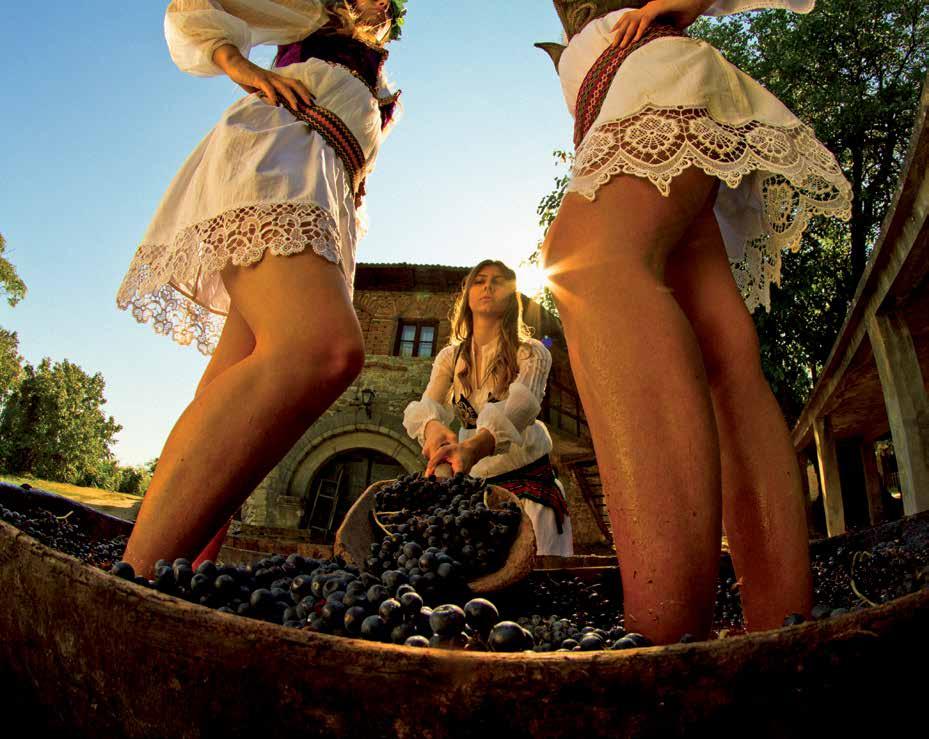
Wine is an essential ingredient for the soup, but it also goes very well with any fish dishes. Not that you need the food as an excuse. The best wines of Eastern Serbia are from the area around the triple border of Romania, Bulgaria and Serbia, near the town of Negotin. One unusual tourist attraction is the original wine cellars in the villages of the Negotin area. The wines here are made from rare old native vari eties of grapes, such as Muscat, using a com bination of traditional methods and modern technology. The personality of these wines never fails to impress.

and sales from the vineyards and apiaries,
the proclamation of the best wine of the year, souvenir sales and a great program of culture and
 11Eastern and Southern Serbia
11Eastern and Southern Serbia
Stara Planina (once known as the Balkan Mountains), is part of the Carpathian-Balkan mountain range. Towns near Stara Planina are Negotin, Zaječar, Knjaževac, Pirot and Dim itrovgrad. Winter savory (Satureja montana) is native to Stara Planina and is valued in the area as a medicinal herb, being used to make a tea known as Rtanj čaj. The plant is a general tonic and is used for a large number of health issues. It is also believed to be an aphrodisiac.
No one should visit this area without tour ing the rivers, lakes and waterfalls. And if all that walking makes you hungry, just think of the porcini mushrooms, roast lamb and Pirot sheep milk cheese that awaits you. This cheese is one of the best of its kind in the world and one of the best-known products of the area. Other features here are hand-made Pirot rugs and the endless jokes about the locals. These mostly focus on their similarity to the Scots, being both sheep farmers and renowned for their frugality.

Spit-roast lamb competition, but also the place to find excellent cheese and honey as well as the famed Pirot rugs and pottery.

+381 (0)10 320 838

Near Pirot is the little town of Bela Palanka. Here, as well as finding natural beauty, histori cal monuments and excellent restaurants, the visitor can go hunting, fishing, paragliding and mountain climbing.
Dani Banica (Pie Days) pie baking competition
Bela Palanka, August
This event is a celebration of traditional cuisine as well as rarely-seen ancient crafts.


(0)18

Still in the south of Serbia, some distance from Pirot is Leskovac. A wealth of archaeological finds have earned it the title of Imperial town, along with the claim that Leskovac was the birthplace of Justinian I. Apart from the Ro man ruins, Leskovac is notable for the Crkva Odžaklija, or Chimney Church, built in the nineteenth century while Serbia was under the Ottoman Empire. Having been forbidden by the Turks to build a church, the resourceful peo ple of Leskovac built this very atypical church, half dug into the earth and camouflaged with a towering pseudo-chimney, a feature never seen on Orthodox churches.

Leskovac took its name long ago from its famed hazelnut woods, lešnik being the Serbian word for hazelnut. Today it is better know for its red peppers. The people of Leskovac speak a dialect of Serbian which preserves many fea tures of the Old Church Slavonic language and even many Serbs find the local difficult to un derstand. However one word, ajvar, is known throughout the land and beyond as the name for a preparation of roast peppers, preserved in jars for use throughout the winter. Leskovac is also known for its fantastic barbecue meats: you’ll probably arrive in the town by car or bus, but once there you must try the Leskovac Train
(leskovački voz), an assortment of grilled meats which arrive at the table one after another like wagons. Nor should you overlook leskovačka mućkalica, a spicy medley of peppers and grilled meats, much prized among gourmets for its spicy flavour.

Concerts of various kinds of music and a competi tion for the biggest hamburger. +381 (0)16 233 361

1 kg pork neck (or mixed pork and veal); 200 gm bacon; 4-5 brown onions; 10 red peppers, roasted, peeled and chopped; 500 gm peeled and chopped tomatoes; 2 heads garlic; salt; ground dried peppers; hot chilli powder if desired.
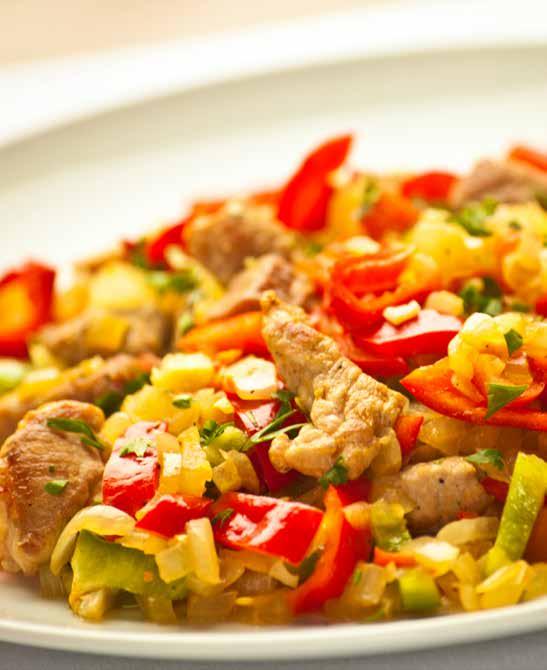
Cut the meat into cubes and make ke babs, salt them and brush with oil then barbecue. While the meat is cooking, chop the bacon into small cubes and fry gently until the fat melts, then add the onion and fry gently in the bacon fat until it falls apart. Add the chopped red pepper. Remove the meat from the skew ers, add to the pan and cook gently until the meat is tender and the sauce has come together. Add the tomato and cook a few minutes more. When finished, add the finely chopped garlic and ground peppers. Add hot chilli powder if desired. Serve with home-made bread or rolls.
Niš is the third largest city in Serbia. It lies on the crossroads of the major routes which con nect Europe to Asia Minor and the Black Sea to the Mediterranean. It is famous for the ar chaeological site of Mediana, built in the third century BCE by Constantine the Great. Niš to day is a modern urban centre known for jazz, film and literary festivals. But the pride of Niš is its cheese pie. In traditional Serbian house keeping, there is a special place for pies, some
of which include apple, pumpkin, sour cherry, poppy seed, dock, spinach, meat and wheat groats. But the true Serbian pie is gibanica, layers of flaky crust filled with cheese, clotted cream and plenty of eggs. Apart from the fill ing, the quality of the pastry is very important for gibanica and at one time housewives would bake this pie only on a wood stove. These days the pastry is mostly bought ready made and the cook’s art is reflected only in their choice.

Not far from Niš is Svrljig - a town whose name is quite unknown to foreigners but which is very attractive as a tourist destination. Apart from excellent honey and the truffles which can be found in the Svrljig woods, the town’s claim to culinary fame is the dull-looking but magical Belmuž, a dish of fresh cheese and maize flour which, as well as being extraordi narily tasty and healthy, is claimed by the peo ple of Svriljig to be an aphrodisiac.

Svrljig, August

Dedicated to belmuž with accompanying events such as a competition for the most beautiful shep herdess, home handicrafts, traditional Svrljig cook ing, shepherd games and a cultural program. +381 (0)18 821 059

600 gm very fresh young sheep cheese (from Svrljig if you can get it); 150 gm white maize flour; salt.
Gently heat the cheese in a deep pot until it has melted but not boiled, then stir in the maize flour very gradually. Continue to cook while stirring continuously for 15-20 minutes. When the cheese comes together in a ball in the middle of the pot and the milk fat separates out to the side, the belmuž is finished. Add salt to taste and serve with a variety of salads as an entrée.
Geographically, Kosovo is the junction of Cen tral and Southern Europe, the Adriatic and the Black Sea. Kosovo’s climate is continental but dominated by mountainous regions. The tur bulent history of this region continues to the present day, but the natural resources, archae ological and historical monuments and culi nary achievements are all available to tourists. Kosovo’s rivers are teeming with tasty treats: freshwater trout, eel, catfish, carp, chub, pike and freshwater crustaceans. The Lipovica and Klecka forests near Lipljan are excellent for hunting, and the Prokletija Mountains and Mount Brezovica have great ski slopes. The urban architecture of Kosovo is a unique mix of east and west, with a lot of mosques and churches, both old and new, local and foreign. There are beautiful Orthodox monasteries in
Dečani, Gračanica, Peć, Prizren and many other Kosovo destinations which offer tourists an insight into the deep history of the Serbian state all the way back to its origins.
The monasteries of Kosovo are known far and wide, as are the wines of Kosovo and Metohija. Kosovo is also known for its white grape bran dy, lozovača. The best wines in the region are reds, including merlot, teran and burgundy. The best-known wines are from Orahovac near Prizren and from the area around Đakovica and Peć, cities famous for their vineyards and or chards. The wide range of charcuterie, chees es and pastry-based foods is similar to that in other parts of Serbia. The deserts of this region are distinctive for their topping of caramelised sugar syrup with vanilla and lemon.



The largest part of central Serbia is Šumadija, whose name means the land of forests. The soil which gave birth to those forests is today sup ports orchards, and the fruit which is the sym bol and trademark of Šumadija is the plum. Among the profusion of excellent varieties, the požegača stands out, having been brought to the Balkans from Syria by Alexander the Great in the fourth century BCE.

There are many ways to spend a holiday in cen tral Serbia: skiing, hunting or even spending time in a village household; you can tour the beauties of nature, historical monuments or search out ethno-oddities. But whether you’re heading for the famous Dragačevo brass festi val in Guča, the Haymaking Festival in Rajac near Ljig, the estates and mausoleum of the royal Karađorđević family in Oplenac near Topola or any of Šumadija’s other fascinating destinations, you can always expect tasty food and an unavoidable aperitif – šljivovica, Ser bia’s world-famous plum brandy. Just as whis ky or tequila come in endless varieties, each the secret and pride of the distillery in which they are produced, so there are many varieties of šljivovica in Serbia. What is common to them is the scent of plums, a golden colour and the
intoxicating power of a strong liquor. Less alco holic, but no less tasty, is a drink prepared from šljivovica when the weather is cold. In Serbia they say that wine is warming and brandy cool

ing so, of course, during winter when a slava (the feast day of a family’s patron saint) is cel ebrated, the drink of choice is Šumadijski čaj (Šumadija tea), or mulled plum brandy.

Ingredients: 500 gm sugar; 350 ml šljivovica; 150 ml water.
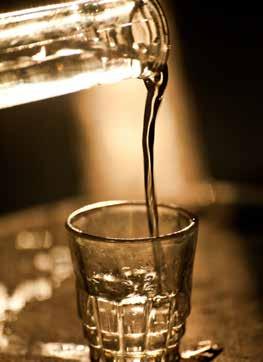

In a deep metal pot, melt and caramelise the sugar until it becomes reddish in colour, then add the water and šljivovica together. Return to the boil (some do this two or three times) and serve im mediately.
This region is known for its competitions for prepar ing and tasting šljivovica and other plum products with an accompanying culture and entertainment program.

Stragari village near Kragujevac, August +381 (0)62 287 211
Šumadijska kraljica (Queen of Šumadija) choice of the best brandy, Gornja Trepča Spa, August. +381 (0)69 622 105
Sajam šljiva (Plum Fair) Osečina, August +381 (0)14 452 311
Apart from making brandy, plums are used for many other excellent dishes, both sweet and savoury (carp with dried plums, plum dump lings, plum jam and others). As a tourist, you shouldn’t pass up the opportunity to try com binations you won’t find anywhere else: grilled prunes wrapped in thin slices of bacon, a deli cate sweet and sour dish which may be served hot or cold. In some places, the stone of the prune will be replaced with cheese, in others with walnuts or olives.
Serbian meals are nothing if not hearty, so you’ll always find plenty of bread, pasta or po tatoes served with a meal, the starch serving as a counterpoint to the spiciness of the other food. Apart from bread, as an entrée or an ac companiment to the main course, there may be proja (cornbread), pogača (a yeast cake similar to bread) or steaming hot potatoes baked under a sač. The sač is a high bell-shaped metal cover for food onto which live coals are piled, so that the food cooks beneath.
Azanja, August.
Selection of the best traditional and modern pogača, with an accompanying program includ ing an accordion competition and an exhibition of national crafts. The festival has also been associ ated with a successful attempt to bake the word’s largest pogača, now listed in the Guinness Book of Records.
+381 (0)26 317 249
Ratina village near Kraljevo, September
A festival dedicated to maize flour cooking with an accompanying ethnological and folk dancing pro gram.
+381 (0)36 316 000
Krupanj, October
Science, exhibitions, competitions, cultural dis plays, entertainment and a sports program, all with a potato theme.

+381 (0)15 584 094

No discussion of the rich cuisine of Central Serbia would be complete without mentioning cabbage dishes, particularly those with mut ton, cooked in large earthenware pots over an open fire. Beans also occupy a special place, especially when cooked in large cauldrons sus pended over a fire. Finally it’s important to mention the wonderful goulashes, salads and
soups of various kinds of fungus. For the ex perts, these include parasol mushrooms (Mac rolepotia procera), chanterelles (Cantharellus cibarius), saffron milk caps (Lactarius delicio sus), porcini (Boletus edulis), giant puffball (Langermania gigantea) and chicken of the woods (Laetiporus sulphurus).


Mrčajevci village near Čačak, September
Competition for cooking wedding cabbage and oth er cabbage dishes along with an extensive cultural, artistic and sports program.
+381 (0)32 343 721

Kraljevo, September
Traditional bean cooking competition in the central square of Kraljevo
+381 (0)36 316 000
Forests, meadows and clearings in the moun tainous area of Central Serbia provide the perfect environment for berry fruits. In the summer season, when there is no snow, the Kopaonik ski centre is overflowing with sweet, healthy blueberries, which visitors may pick themselves or buy.
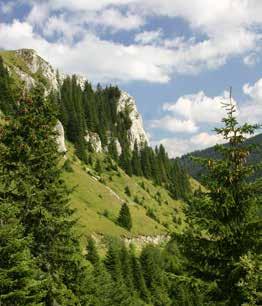

Mount Kopaonik, July Educational, competitive and recreational event re lated to picking, growing and processing both wild and cultivated blueberries.






Western Serbia is a region of charming towns and idyllic mountain villages. Tourism focus es on the mountains – Zlatibor, Tara, Zlatar, Golija and the Pešter Plateau – but there are many other places of interest, such as the Uvac River Gorge, the teeming waters of the Drina, Priboj Spa, the Potpećka and Stopića caves, the open-air museums Staro Selo (Old Village) in Sirogojno and Drvengrad in Mokra Gora, the Šarganska Osmica narrow gauge railway, the Mileševa, Uvac and Rača monasteries and a number of timber churches. Shepherd Days, Kosjerić, Arilje raspberries, Užice prosciutto, Zlatar cheese, Užice fruit brandy, komplet le pinja (egg, clotted cream and prosciutto sand wich) and buckwheat pie are just some of the attractions of this region. At every step the visitor can enjoy beautiful and healthy nature, examples of remarkable cultural traditions and all kinds of activities, all accompanied by a wealth of culinary experiences.

Kajmak, a slightly aged, salted clotted cream is a traditional dairy product in the mountainous regions of Serbia. Creamy and slightly tart, it is served as an entrée, as a spread or as an addi tion to meals (rather like butter or sour cream).
It is made by fermenting the milk fat obtained by scalding milk. The Serbian saying “Take the kajmak off”, apart from its primary culinary meaning, means taking for yourself the most valuable part of something. In that sense, the

kajmak of tourism in Serbia is the spectacular Mount Zlatibor, the closest towns to which are Čajetina, Užice and Nova Varoš or the village of Mokra Gora with the ethno-village of Dr vengrad, built by film director Emir Kusturica.
But there’s more to Zlatibor than the famous kajmak; you’ll also find a wide range of Zlati bor šljivovica, cheese, and smoked and dried meats.
Tourist Events: Pršutijada (Charcuterie Fair)

Mačkat, January
Exhibition and sales of dry meat products: beef and pork prosciutto, bacon, sausages, smoked mutton and other smoked meats, all with the obligatory accompaniment of musicians and arts-and-culture associations.
+381 (0)31 841 646

Šljivovica village on Mount Zlatibor, April
As well as a competition for the best brandy maker in the Zlatibor district, there are also toastmaster and pie making competitions.
+381 (0)31 841 646
Mount Golija, near the towns of Raška, Ivan jica and Novi Pazar, is a biosphere and nature reserve under UNESCO protection. Among its many delights, Golija offers gastronomic treats in the form of mushroom tasting and, if you’re feeling energetic, mushroom picking.

100 gm fresh chanterelles; 100 gm fresh porcini;
1 garlic clove (or half a spring garlic cut in two or three pieces);
1 teaspoon butter;
1 tablespoon olive oil; salt and pepper; 200 ml sour cream; 50 gm each of parmesan and feta; basil.
Fry the mushrooms for ten minutes in the butter and oil, then add the chopped garlic. Season with salt and pepper, then add the grated cheese and sour cream. Stir over heat until the cheese melts and at the very end add finely chopped basil, preferably fresh.

In the Zlatibor district, in the Morava and Rza va river basins, lies the town of Arilje, known throughout the world for its raspberries. Ser bia is the world’s second-largest producer of raspberries, a fruit known as red gold because of its nutritional and culinary value. In West ern Serbia this red gold is used for juices, syr ups, creams, ice creams, cakes and tarts.




Ingredients for cake: 6 egg yolks; 250 gm flour; 50 gm sugar; 200 gm butter; 1 tsp baking powder.
Ingredients for topping: 6 egg whites; 300 gm sugar; 600 gm strawberries; 100 gm crushed walnuts; 1 tsp vanilla sugar.
Preparation: Beat the egg yolks with 50 gm sugar, add the butter and flour mixed with baking powder, bring the dough together and then spread it evenly in a baking tin.
Bake in a preheated oven at 180˚ C. While it is baking beat the egg whites until stiff with 300 gm of sugar and vanilla sugar. When the cake is browned, remove from the oven and strew it with the chopped walnuts; arrange the raspberries on top and cover it with the meringue mix ture. Turn the oven down to 100˚ C and return the cake until a crust forms on the meringue.

Four kilometres from Nova Varoš rises Mount Zlatar, which boasts skiing and paragliding among its attractions for tourists. The Uvac River Gorge lies between the northern slope of the Zlatar and the southern spur of the Zlatibor massif. This region is unique as the home of the Griffon Vulture. The area around the Uvac River Gorge has been proclaimed a special na ture reserve in an attempt to protect this spe cies. Among the rare birds with colonies here are grey eagles, wallcreepers, eagle owls and kingfishers. Mammals from the European Red List represented here include species of bats and otters.
Foodwise, this area is known for Zlatar cheese, the recipe for which is not a secret although, in fact, no one else can make it. Only here and no where else in the world are there such pastures and such water, which are why the milk here produces cheese of such a special quality and aroma. An additional trick is that the cows are milked by hand, maintaining hygiene without chemicals and the use of wooden vessels. Sjeni ca cheese is used to make a number of exquisite local dishes. The gibanica here is the same as in other parts of Serbia, yet different, because the pastry is made from buckwheat flour. One excellent specialty of this area is this pie made from Zlatar cheese and buckwheat flour.
Izložba Meda (Honey Show) and Darovi Zlatara (Zlatar’s Bounty)
Nova Varoš, July-August
Competitive event for the choice of the best cheese; competition for the best pie made from buckwheat pastry; prizes for the household with the most cows and the youngest spouses as well as a competi tion for izvici a traditional kind of singing without instrumental accompaniment.
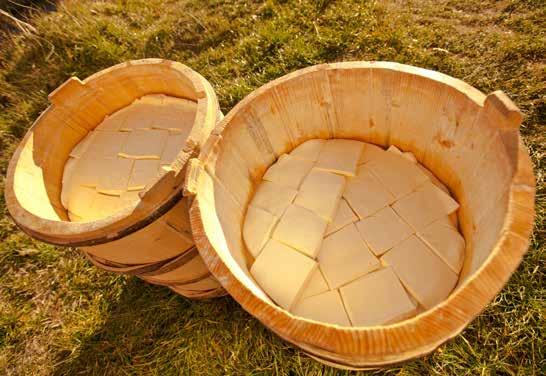
+381 (0)33 261 2621


Selection of the best sweet or savoury pie and exhi bition of rugs, ethnic crafts, paintings, charcuterie and dairy products.
+381 (0)20 744 843
Sjenica sudžuk is a local sausage made to re semble the meander of the River Uvac. It is prepared from beef and beef suet in a propor tion of four to one. Sudžuk is cold smoked and then dried. From the slope of Mount Pešter and the Pešter Plateau, where the towns of Sjenica and Novi Pazar lie, comes Sjenica cheese with its exceptional taste and aroma. The area also produces exceptional peppers and cream.
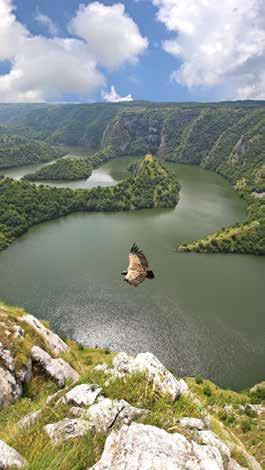







Vojvodina in the north of Serbia is a flat region of isolated farms, wealthy villages and towns with Middle European architecture and culi nary traditions. One of the main agricultural products recalled by history from the sixteenth century is the healthy and tasty Futog cabbage, named after the town on the outskirts of Novi Sad. Cabbage is used in Vojvodina both as a meal in itself and as an accompaniment, as a filling for savoury pies or pancakes, and as a soup. Pickled cabbage is well known as a salad, but is also a basic ingredient of sarma and the even better known podvarak. Sarme are pack ages of spiced minced meat and rice wrapped in a leaf of pickled cabbage, while podvarak is braised, finely chopped pickled cabbage, usu ally served with pork knuckle or turkey, goose, duck or, not uncommonly, with fish.

a whole pickled cabbage, cut into fine strips; oil; a large brown onion; a handful of rice; whole peppercorns; bay leaf; ground dried peppers; parsley; salt.
Finely chop the onion and fry it in oil, adding a little water, until transparent. Add the cabbage, bay leaf and whole pep percorns and braise for an hour, occa sionally adding a little mixed water and brine from the cabbage. Add a handful of rice and more liquid and simmer until the rice is cooked. Add the ground red peppers and finely chopped parsley and serve hot.
Tourist Event:
Futoška Kupusijada (Futog Cabbage Festival) Futog, October
Competition for preparing cabbage dishes, com petition for growing the largest cabbage and an arts-and-culture program.
+381 (0)21 6617 343 +381 (0)64 1629 639


As well as the Danube and Sava on its borders, Vojvodina is ornamented by a number of peace ful, meandering rivers as well as a wealth of both natural and artificial lakes. Because of this, freshwater fish dishes dominate the menu of the region.


Vojvodina has many events and competitions involving the preparation of traditional fish dishes, accompanied by cultural and entertainment programs.
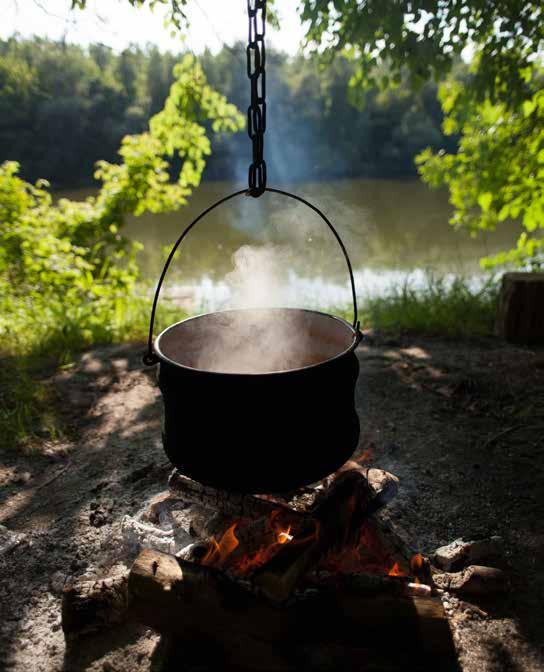

Apatinske ribarske večeri (Apatin Fishing Evenings) Apatin, July +381 (0)25
Somborski kotlić (The Sombor Cauldron) Sombor, July +381 (0)25
Zlatni kotlić Pančeva (The Pančevo Golden Cauldron) Pančevo, August +381 (0)13
Because Vojvodina is mostly flat, a stand ard joke here is that when you stand on a pumpkin you can see Vienna. No doubt this line-of-sight communication explains why Vojvodina cakes, tarts, pies and strudels are from the Viennese school, which is to say excellent. The ec lectic cuisine illustrates the wealth of dif ference in Vojvodina, with the manifold influences of all its peoples and nationali ties or ethnic groups, of which there are more than 25.


Kikinda, October
Competition for the heaviest pumpkin and the longest marrow and a program including fun and games with pumpkins, an autumn carnival and a Banat breakfast.

+381 (0)230 426 300
Dolovo, September
As well as displays and sales, this event has a competitive section in which members of the As sociation of Rural Women from all over Serbia and the region take part.
+381 (0)13 351 366

Fruška Gora and Mount Vršac are the only two high points which interrupt the otherwise endless plain of Vojvodina. The slopes of these mountains and their rolling surrounds are ideal for vineyards and orchards. Wines, made from ancient and venerable species of grapes, and fruit brandies are found everywhere in Vojvo dina, but the aromatic red desert wine bermet, a close relative of port, Madeira and sherry, can be found only in Sremski Karlovci. Through the Austro-Hungarian court, this wine became a favourite in European high society and beyond – legend has it that a supply of bermet went down with the Titanic.



There are a large number of events in Vojvodina devoted to wine and fruit brandy, with tastings and various sorts of cultural and entertainment programs.

Vinofest (Wine Festival) Vršac, March +381 (0)13
Novi Sad, May +38165
Kovilj, June +381 (0)21
Festival hrane, pića i zanatskih proizvoda Bodrogfest (Bodrogfest Festival of Food, Drink and Craft Products)
Bački Monoštor, August +381 (0)25 807504
Dani berbe grožđa (Grape Picking Days)
Vršac, September +381 (0)13 832
Berbanski dani (Picking Days) Palić, September +381 (0)24
350
Pudarski dani (Vineyard Guard Days) Irig, September +381 (0)22

Among the various excellent charcuterie prod ucts of Vojvodina, sremski kulen (pork salami from Srem) is notable. This large, fat sausage of minced pork and bacon seasoned with hot

peppers and salt is aged well to develop the fla vour. Kulen is excellent as an entrée, in sand wiches or as an aromatic addition to pasta and other dishes.
During February and May there are a number of festivals and other events in Vojvodina connected with making, tasting and selling traditional meat products along with various kinds of cultural and entertainment programs.
Šid, February +381 22 710 088

Kačarevo, February +381 64 1733 188
Turija, February +381 21 737 597, +381 63 77 19 088
Bački Petrovac, May +381 (0)21 780 478
Erdevik, May +381 22 710 088



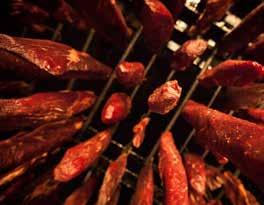




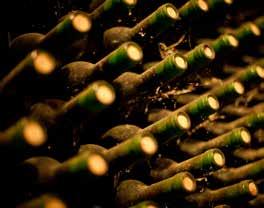


Serbia is a country with beautiful natu ral scenery, important archaeological sites and historic monuments, but it is also a country of hospitable people and delicious food. This is just an introduc tory tour of places, events, food and drinks which should not be missed. Within easy reach of most of them are many other de lights which avid travellers will discover for themselves when they take the next step. We’ve recommended just some of the wealth of gastronomic joys Serbia has to offer, but when you follow your own nose and palette through this fascinating coun try, your senses will show you much, much more.


National Tourism Organisation of Serbia Čika Ljubina 8, Belgrade Tel: +381 11/6557-100
Fax: +381 11/2626-767
E-mail: office@serbia.travel www.serbia.travel /serbiatourism
For publisher MSc Marija Labović, acting director
Smiljana Novičić
Photography Dragan Vildović, Dragan Bosnić, Branko Jovanović, Vladimir Ćorović
Text
Vladislava Vojnović
Marijana Markoska Soulfood logo and textures Nikola Radojčić

Translation Steve Agnew Printing Futura, Novi Sad Circulation 2,000
Supported by Deutsche Gesellschaft für Internationale Zusammenarbeit (GIZ)
7th edition in English, reprint, 2022
© National Tourism Organisation of Serbia ISBN 978-86-6005-430-4
CIP - Каталогизација у публикацијиНародна библиотека Србије, Београд 338.48-6:641/642(497.11)(036)
VOJNOVIĆ, Vladislava, 1965Soulfood Serbia / [text Vladislava Vojnović ; photography Dragan Vildović ... [et al.] ; translation Steve Agnew]. - 8th ed. in English. - Belgrade : National Tourism Organisation of Serbia, 2017 (Beograd : Službeni glasnik). - 44 str. : fotogr. u bojama ; 20 x 24 cm
Podatak o autorki preuzet iz kolofona. - Tiraž 2.000. ISBN 978-86-6005-430-4
COBISS.SR-ID 241081100